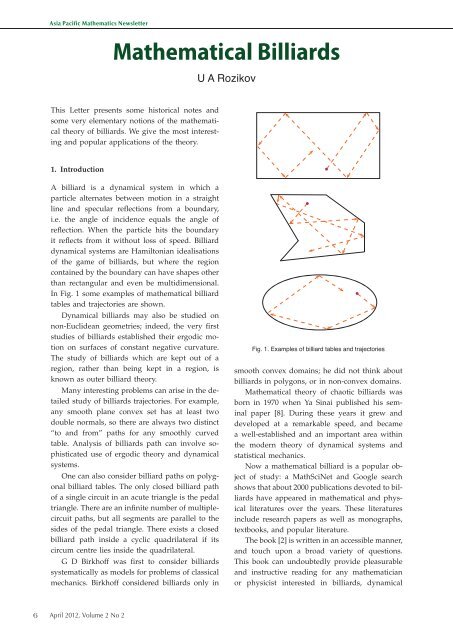Mathematics Newsletter
Mathematics Newsletter
Mathematics Newsletter
Create successful ePaper yourself
Turn your PDF publications into a flip-book with our unique Google optimized e-Paper software.
6<br />
Asia Pacific <strong>Mathematics</strong> <strong>Newsletter</strong><br />
Mathematical Billiards<br />
This Letter presents some historical notes and<br />
some very elementary notions of the mathematical<br />
theory of billiards. We give the most interesting<br />
and popular applications of the theory.<br />
1. Introduction<br />
A billiard is a dynamical system in which a<br />
particle alternates between motion in a straight<br />
line and specular reflections from a boundary,<br />
i.e. the angle of incidence equals the angle of<br />
reflection. When the particle hits the boundary<br />
it reflects from it without loss of speed. Billiard<br />
dynamical systems are Hamiltonian idealisations<br />
of the game of billiards, but where the region<br />
contained by the boundary can have shapes other<br />
than rectangular and even be multidimensional.<br />
In Fig. 1 some examples of mathematical billiard<br />
tables and trajectories are shown.<br />
Dynamical billiards may also be studied on<br />
non-Euclidean geometries; indeed, the very first<br />
studies of billiards established their ergodic motion<br />
on surfaces of constant negative curvature.<br />
The study of billiards which are kept out of a<br />
region, rather than being kept in a region, is<br />
known as outer billiard theory.<br />
Many interesting problems can arise in the detailed<br />
study of billiards trajectories. For example,<br />
any smooth plane convex set has at least two<br />
double normals, so there are always two distinct<br />
“to and from” paths for any smoothly curved<br />
table. Analysis of billiards path can involve sophisticated<br />
use of ergodic theory and dynamical<br />
systems.<br />
One can also consider billiard paths on polygonal<br />
billiard tables. The only closed billiard path<br />
of a single circuit in an acute triangle is the pedal<br />
triangle. There are an infinite number of multiplecircuit<br />
paths, but all segments are parallel to the<br />
sides of the pedal triangle. There exists a closed<br />
billiard path inside a cyclic quadrilateral if its<br />
circum centre lies inside the quadrilateral.<br />
G D Birkhoff was first to consider billiards<br />
systematically as models for problems of classical<br />
mechanics. Birkhoff considered billiards only in<br />
April 2012, Volume 2 No 2<br />
Mathematical Billiards<br />
U A Rozikov<br />
Fig. 1. Examples of billiard tables and trajectories<br />
Fig. 1. Examples of billiard tables and trajectories<br />
smooth convex domains; he did not think about<br />
billiards in polygons, or in non-convex domains.<br />
Mathematical theory of chaotic billiards was<br />
born in 1970 when Ya Sinai published his seminal<br />
paper [8]. During these years it grew and<br />
developed at a remarkable speed, and became<br />
a well-established and an important area within<br />
the modern theory of dynamical systems and<br />
statistical mechanics.<br />
Now a mathematical billiard is a popular object<br />
of study: a MathSciNet and Google search<br />
shows that about 2000 publications devoted to billiards<br />
have appeared in mathematical and physical<br />
literatures over the years. These literatures<br />
include research papers as well as monographs,<br />
textbooks, and popular literature.<br />
The book [2] is written in an accessible manner,<br />
and touch upon a broad variety of questions.<br />
This book can undoubtedly provide pleasurable<br />
and instructive reading for any mathematician<br />
or physicist interested in billiards, dynamical<br />
1


